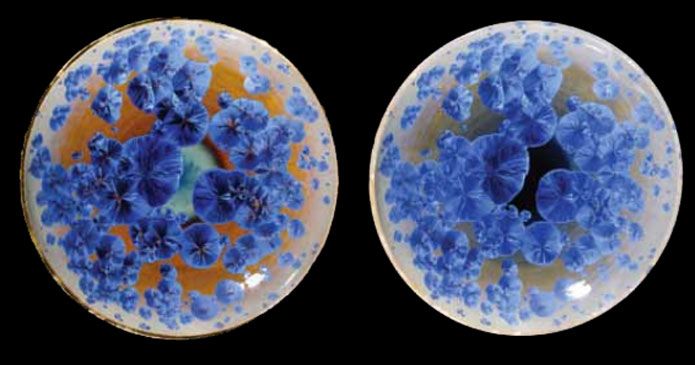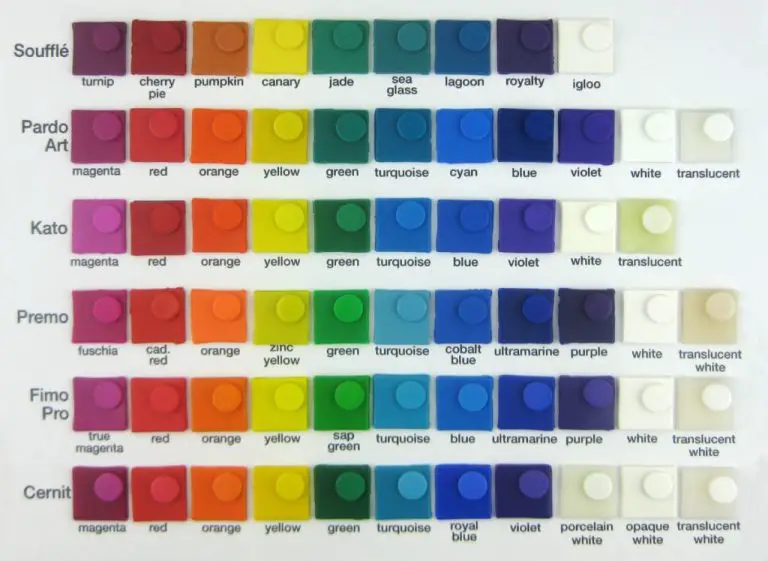What Is Crystalline Glaze Made Of?
What is Crystalline Glaze?
Crystalline glaze is a type of ceramic glaze that contains crystals that form as the glaze melts and cools. The crystals provide a shimmering, sparkling effect on the finished surface.1 Crystalline glazes first emerged in the US in the 1960s, pioneered by ceramic artists like Hammond and Soldner.2
The main characteristics of crystalline glazes are their glossy, sparkling appearance and texture. The glaze contains crystalline-forming minerals like zircon, zinc oxide, or titanium dioxide. As the glaze melts in the kiln, these minerals partially dissolve and recrystallize as it cools, forming visible crystal clusters on the surface.
Key Ingredients
The key ingredients in crystalline glazes are:
Silica – This provides the silicon dioxide needed to form crystals. Silica is a key component, typically making up around 25% of the glaze recipe. It aids crystal growth during firing. Source
Zinc Oxide – Around 25% of a crystalline glaze recipe is zinc oxide. The zinc promotes crystal formation, with its solubility in glaze increasing as the kiln temperature rises. This allows zinc to move through the melt and form crystals as the glaze cools. Source
Alumina – Alumina (aluminum oxide) may be added in small amounts, typically 3-5%, to help induce fine crystallization. Too much can prevent crystal growth. Source
Colorants – Metal oxides like cobalt, copper, or chromium oxide can be used to introduce color. Care must be taken to avoid disruption of the crystallization. Source
How Crystalline Glazes Work
Crystalline glazes contain a high zinc content, usually around 60-65% zinc oxide. This high zinc content allows crystals to form when the glaze undergoes controlled cooling. During the firing process, crystalline glazes are heated to very high temperatures, between 2300°F and 2350°F (1260°C to 1290°C). At these extreme temperatures, the molecules in the glaze move freely and become disordered. As the glaze cools, the zinc oxide begins to crystallize and form structured crystals. The key is controlling the cooling process. Slow cooling, or annealing, allows the glaze time to form larger, more visible crystal structures. Faster cooling produces smaller crystals that may not be visible to the naked eye.
The process of crystallization gives crystalline glazes their distinctive visual appearance. The formations of crystals refract light differently than standard glazes, creating surfaces that shimmer and reflect light in unique ways. The patterns and shapes of the crystals vary greatly depending on the glaze ingredients and firing process. Mastering crystalline glazes requires controlling variables like chemistry, temperature, and cooling to achieve the desired crystalline effects.
Firing Process
Firing crystalline glazes requires reaching very high temperatures, usually between 2200-2300°F. The glaze must mature at this peak temperature, which requires a long hold time in the kiln. Typical hold times are 8-12 hours at maturity.1 This gives the crystals time to nucleate and grow to an optimal size and pattern.
The cooling cycle is also critical for crystalline glazes. The kiln must be cooled slowly, usually around 150-200°F per hour. This allows the glaze to crystalize properly as it cools through its freezing point. Fast cooling can result in a glaze with small, underdeveloped crystals. The entire firing, including warm-up, maturity hold, and controlled cooling, can take over 24 hours to complete.
Firing to the high temperatures required for crystallization demands that the kiln and shelves be in excellent condition. The kiln must also have the capacity to reach the necessary temperatures.
Appearance and Texture
Crystalline glazes are highly prized for their dazzling visual qualities. The glaze has a sparkly, gem-like surface reminiscent of precious stones. The crystals form as the glaze melts and then re-solidifies during firing, resulting in a smooth, glassy texture.
The crystalline surface is translucent, allowing light to pass through and reflect off the embedded crystals. This creates a sense of depth and brilliance, as if one is gazing into a pool of glittering water. The translucent quality also interacts beautifully with the clay body beneath, bringing out subtle colors and patterns in the clay.
No two crystalline glazes fire exactly the same, contributing to the sense of a one-of-a-kind “frozen landscape” on each finished piece. The crystalline structure emerges randomly within the glaze, yielding endless variations in the sparkling surface.
Uses and Applications
Crystalline glazes are prized for their ability to highlight texture through the formation of visible crystals on the surface. The sparkling appearance and irregular shapes make crystalline glazes ideal for decorative accent pieces where visual interest is desired. Bowls, mugs, vases and other ceramic wares often utilize crystalline glazes for focal areas like the interior or just on the rim.
Crystalline glazes also pair well with other glazes like satin mattes and high gloss glazes. The shimmering crystalline areas create nice contrast against the smooth textures of other glazes. Using crystalline glazes solely as accents allows the unique visual properties to stand out and not overwhelm a piece.

Some artists also use crystalline glazes in sculptural pieces, either covering the entire sculpture or just portions of it. The crystalline areas become another texture and visual element to incorporate when designing abstract sculptures. When applied thoughtfully in key areas, crystalline glazes can elevate standard ceramic forms into intriguing art objects.
Advantages
Crystalline glazes offer several key advantages that make them a popular choice among ceramic artists and potters:
Crystalline glazes create a unique aesthetic not achievable with regular glazes. The crystalline structures form dazzling patterns as the glaze cools, resulting in a striking, one-of-a-kind look. The visual depth and dimensionality of crystalline glazing is prized by artists and collectors.
Crystalline glazed ware is highly durable and resistant to chipping, crazing, and scratching. The tightly bonded crystalline structures make the glaze surface very hard and robust. Pieces can be used frequently without wear and tear over time.
Crystalline glazes can be applied to a variety of clay bodies, including stoneware, porcelain, and earthenware. The glaze ingredients can be adjusted to be compatible with different firing temperature ranges. This versatility allows potters to use crystalline effects on diverse pieces.
Overall, crystalline glazing provides beautiful, resilient finishes not possible through regular glazing. The unique properties allow for creative applications across types of ceramic ware.
Challenges
Crystalline glazes come with some unique challenges, especially compared to more traditional glazes. Some of the key difficulties include:
Crystalline glazes require specific high-temperature firing, usually around cone 10-11 which is 2,300–2,400°F. This is significantly hotter than typical stoneware or porcelain firing temperatures. Achieving these high temperatures can be difficult without a specialized kiln (see https://ceramicartsnetwork.org/daily/pottery-making-techniques/glazes-and-glazing/how-to-successfully-fire-crystalline-glazes/).
The high-fire temperatures and growth of crystals during firing can also lead to cracking or crazing issues with the finished pieces. Proper clay bodies and glaze applications are required to minimize cracking.
Some crystalline glazes contain highly toxic ingredients like cadmium, lead, and barium. Special safety precautions are required when using these formulations (see https://digitalfire.com/4sight/hazards/cadmium_and_other_toxic_heavy_metals_in_glazes_is_your_work_safe_52.html). Many artists now use safer substitute materials.
Notable Crystalline Glaze Artists
Here are some notable crystalline glaze artists and examples of their work:
Bill Powell is considered a pioneer of crystalline glazes. He has been perfecting his crystalline glaze recipes and techniques since the 1960s. His pieces often feature earthy tones like browns, blues, and greens with striking crystal formations. Examples of his work can be seen on his website billpowellartworks.com.
Peter Smith is a British potter known for his beautiful crystalline pots. He focuses on creating functional pieces like vases, bowls, and cups with mesmerizing crystalline effects in shades of blues and greens. His extensive research on formation helped progress the crystalline glaze field. Some of his works are shown at crystallineglazes.com/peter-smith.
Robert Hessler was an American artist who revived the lost art of crystalline glazing in the 1960s. His recipes using zinc and felspar created stunning earthy crystalline effects in natural tones. He shared his glaze research openly to help advance the field. Examples of his works are at themarksproject.org.
Further Resources
Those interested in learning more about crystalline glazes have several excellent resources available:
The book Crystalline Glazes by Diane Creber provides in-depth information on the history, chemistry, and techniques for creating crystalline glazes. Creber includes hundreds of photographic examples and 50+ glaze recipes in the book, published in 2009 by A&C Black.
DigitalFire.com has a comprehensive glossary entry on crystalline glazes explaining their chemistry and mineral formation in detail. The site also features many crystalline glaze recipes and tips.
Ceramic Arts Network has published several helpful articles on crystalline glazing, like this tutorial on making your own crystalline glazes by Andy Ward.
YouTube has many crystalline glazing technique videos from expert ceramic artists and teachers like John Britt and Simon Leach.

